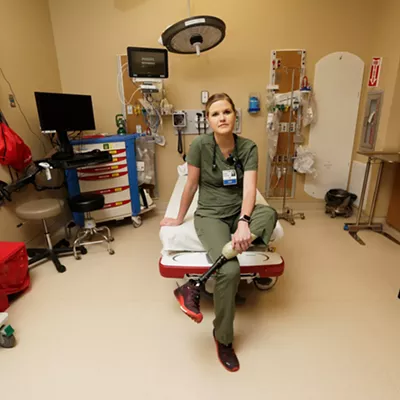On April 18, 2000, when Spokane County Sheriff's deputies arrested Robert Lee Yates Jr. on his way to work, the Serial Killer Task Force beat the odds. Only 30 percent of serial killers are ever apprehended, and they got the guy who would later admit to 13 murders. The local and national media rejoiced in a job well done. But now, a year after that arrest, a new book is calling into question how well that job was really done.
Former L.A. detective Mark Fuhrman, now a radio talk show host and author, claims Yates should have been arrested in 1997 -- before he killed another 10 women. In his new book, Murder in Spokane (Cliff Street Books), he charges that missed clues and an investigation mesmerized by technology added up to some shoddy police work. That the crime was solved at all, he says, was in spite of the task force's efforts.
"They tripped over a trophy elk two weeks dead and claimed they shot it," Fuhrman says from his home in Sandpoint.
Local law enforcement is reluctant to offer any critiques of the book, as they haven't read it yet (it hits bookstores on Tuesday). At the Sheriff's Department, Spokesman Dave Reagan says Sheriff Mark Sterk has no comment now. He adds that the department is devising a response that should be ready within a few weeks. He does, however, admit the investigation was a learning experience for everyone involved and said the silence on details has been a necessity since the court proceedings have been ongoing.
"The investigation was thorough and aboveboard," Reagan says. "It was conducted as professionally and expediently as we could, and the community has local law enforcement it can be proud of."
The problem is that Fuhrman isn't waiting for the Sheriff's Department to devise its response; he's going on a media tour starting Monday with appearances on FOX-TV, Good Morning America and 48 Hours. Just as quickly as people were convinced that Spokane's finest did a good job, they could have their minds changed if no one is willing to argue the other side of the story.
As for the Spokane Police Department, Spokesman Dick Cottam says Fuhrman never had any access to the task force, which means he may not have the full picture. But then, the SPD doesn't appear ready to help the public get the full picture either.
"The results speak for themselves," Cottam says. "A major serial killer in the nation was caught with overwhelming evidence."
Cottam adds that Police Chief Roger Bragdon has no comment on the book's allegations at this time.
Fuhrman says the reason the city and county police departments are reluctant to talk is because there are some very troubling questions raised that will be uncomfortable for them to answer.
Since becoming known across the nation during the O.J. Simpson trial, Fuhrman has become an author, penning both Murder in Brentwood, about that infamous Simpson case, and Murder in Greenwich, which led to the arrest of Michael Skakel, a scion of the Kennedy clan, for the 25-year-old murder of Martha Moxley.
Fuhrman's role in the Simpson case was ultimately ignominious, as he was caught in a lie on the stand (that he never used the "n" word to describe African-Americans) that Simpson's legal team grabbed onto to create reasonable doubt. Although many other factors played into Simpson's acquittal, many believe the concoction that a racist cop planted a bloody glove at Simpson's house allowed Johnnie Cochran to divert the jury's attention away from the overwhelming physical evidence against his client.
But it didn't seem to hurt Fuhrman's post-police career. He has been a fixture on national news programs as a consultant and source. Then came the books, and more recently he started a radio talk show on KXLY-AM 920 with Mike Fitzsimmons, who plays a major role in Murder in Spokane. While not a trained journalist, one thing Fuhrman does have going for him is that he's been there. While many crime reporters have only worked from the outside, Fuhrman has seen it from the inside and can, as he puts it, "call bullshit" when cops try the usual snowjobs on him.
The Spokane serial killer case caught his attention before it was even called a serial killer case, back in 1997. He devoted hours and hours to the subject on his radio show, and he decided to write a book about it before they made an arrest.
"I'm very objective about this," says Fuhrman. "This is nothing personal for me, but people in the city and the county better wake up. If nobody gets to the bottom of what happened in this case, well, let's just say that if you don't learn from history, you're bound to repeat it."
Although his book is somewhat repetitive and pumped up with a little too much detective bravura, it is riveting for anyone who followed the story. He confirms things people believed, and he reveals new details that paint an even more chilling portrait of the killer. Fuhrman establishes that Yates moved his victims, wanting them to be found by police. And he reveals the so-called signature of the killer, that many of the victims had plastic bags over their heads. He says Sterk told him that Yates even engaged in sexual torture and necrophilia.
But the book's narrative is driven more by the police's investigation -- or lack thereof -- than by the killer's actions. His critiques of the joint investigation, which eventually wound up being just the county's, fall into three categories: poor leadership and organization; too much reliance on technology; and failure to employ basic investigative techniques. The result was that Yates stayed on the streets two years too long, he says.
Fuhrman says organizing the task force appears to have distracted the police from catching the killer. This is just what happened in the Green River case, where infighting between departments kept the investigation on the slow track. Two different sheriffs and two different police chiefs presided over the task force, as elections changed the leadership midstream. But the worst decision, he says, was not to share information with the public. At one point, Fuhrman quotes a Sheriff's Department spokesman saying that sharing information can hurt serial killer investigations. Fuhrman says the truth is quite the contrary, and giving the public a reasonable amount of information can help catch the killer. The task force wouldn't even confirm good information that made it into the press and reject bad information, making the situation even more chaotic than it needed to be.
As for technology, Fuhrman says, "Chuck it. Technology is being leaned on so heavily that people are forgetting basic police work. They didn't even interrogate anyone -- they were on a blood drive."
Since the crime scenes yielded valuable DNA information, Fuhrman says the task force focused on getting blood samples from anyone who came in contact with the women in question. Fuhrman wonders if they even screened out samples by blood type, which could have cut down the number needed to be tested by a significant percentage. More than 2,000 samples were ultimately gathered -- about four a day, by Fuhrman's calculation. Fuhrman believes they were so focused on getting a match that they failed to do other things, like put cops down on East Sprague, where the women were all going missing from.
But worst of all, he says, for whatever reason, good leads were not being followed up on. He writes a lot in the book about a lead that got called into his show about a maroon sedan seen near one of the dumpsites. No matter how hard he and Fitzsimmons tried, they couldn't get the task force to check out the lead (although, ultimately, it didn't appear to have anything to do with the case).
The task force, Fuhrman says, sat on a golden clue for two years. Just after 16-year-old Jennifer Joseph's body was found in a hayfield in northeast Spokane County on August 26, 1997, a report came in to the police that she was last seen getting into a white Corvette on East Sprague. This fact was revealed in the affidavit against Yates, although that document doesn't list when the clue came in. Fuhrman says Sheriff Mark Sterk confirmed to him that it came in just after she went missing.
Fuhrman says it's obvious that the report made it into a roll call meeting, when beat cops are briefed on things to be on the lookout for, since Officer Corey Turman pulled Yates over in a white Corvette just a month after Joseph's body was found. Turman apparently filed a report on the incident, but for reasons that baffle Fuhrman, it went into some kind of black hole, only to emerge again when Yates was identified as a suspect two years later.
"Turman could have solved the case right there," Fuhrman writes in his book. "Imagine the scenario. Officer Turman questions Yates, finds probable cause to search the car, finds a small-caliber handgun, brings Yates in for questioning, gets a search warrant for the Corvette, the search reveals blood and other evidence connected to Jennifer Joseph, Yates is arrested for her murder, the killings stop. There's no serial killer and no task force. Turman gets a commendation and probably makes detective in a couple years. Unfortunately, it didn't happen that way."
Fuhrman says when he was a detective, a white Corvette clue would have been almost too good to believe since the sports cars are much more rare than other models. Usually it's more like a blue Subaru or a gray Taurus. And he says even if the police decided the clue wasn't going anywhere, they could have released it to the public. Bob Keppel, who investigated the Ted Bundy killings in Washington state in the 1970s, had a clue like that, too. A guy in a brown Volkswagen was seen near where two women were abducted and killed at Lake Sammamish State Park. Keppel released the information, it was put in the media and Bundy left the area. (His girlfriend even called the police twice to report he drove a brown Volkswagen, but she was ignored. Bundy was later caught in Utah.)
A little closer to home, the Spokane Police Department released a description of the car that was seen near the site of the abduction of three Mukogawa students three days after the crime. The criminals were caught shortly thereafter. Fuhrman raises the possibility that the police didn't react as energetically because the women being killed were engaged in drug use and selling their bodies.
"Lets face it, the difference is these victims were rich and powerful and from Japan," says Fuhrman. "You can't tell me that Darla Sue Scott, Shawn Johnson, Shawn McClenahan, Laurie Ann Wason and Linda Maybin didn't get into a white Corvette. Once they couldn't work that clue, they needed to release it. Heck, Yates' next-door neighbor probably would have called [the police] the next morning."
Fuhrman says the case could have been solved again after August 1, 1998, when Christine Smith reported an assault and robbery. She didn't know it at the time, but Yates had actually shot her. The description she gave to the investigating officer, Fuhrman says, was more than enough to catch Yates. Yates told Smith that he was a helicopter pilot with five kids. Maybe he was lying, but maybe not, says Fuhrman. It turns out he wasn't, and Fuhrman says after maybe three or four phone calls he could have had him as a suspect. Why wasn't the case pursued? Fuhrman says that's just the kind of question he'd like to ask somebody if the police would break their official silence.
Finally, on September 15, 1999, Yates was brought in for questioning. Fuhrman isn't sure if he was just the next name on the list (which, if alphabetically arranged, gave Yates even more time among the free) or if there was new information pointing to him. But Fuhrman thinks it was a routine interview -- a couple of questions and a request for a blood sample. Yates called back three days later to say he would not supply the blood sample voluntarily. But it was probably easier than that, since they had a fingerprint on one of the plastic bags he used on a victim. As a military man, Yates' fingerprints would be on file with the Department of Defense, a database available to civilian law enforcement. A match could have been run right then and there.
"And they don't consider Yates a suspect until he refused to give a blood sample," Fuhrman writes. "Even then, they waited four months to retrieve fibers from the Corvette. And then they waited another three months before actually getting a search warrant on the Corvette and recovering the blood and other evidence that linked Yates to the murder of Jennifer Joseph. Why did it take the task force so long to make a case against Yates? As curious as I am to find out what the task force was doing for those seven months, it really doesn't matter. They had already wasted two years, and watched 10 women die."
Fuhrman does speculate that the county wanted to wait until after Christmas Eve, when the city would drop out of the case, to tip their hand. So another question for Bragdon would be if he knew the county had a suspect when he dropped out due to financial problems brought on by I-695.
Ironically, Fuhrman also postulates that if Yates had simply submitted to the blood test, no red flags would have been raised and his blood sample would still be sitting in line with hundreds of others at a crime lab somewhere while he still walked the streets.
"All it takes is a brain to catch a suspect -- not a computer, not a DNA strip," says Fuhrman. "They leaned so much on technology, they forgot how to be cops."
Fuhrman isn't sure what the fallout will be from his book, but he hopes it leads to a better understanding of what really happened -- and better police work in the future.
"Maybe Turman's [report on pulling over Yates] got lost -- it can happen -- but somebody needs to just admit it," says Fuhrman. "In L.A., people wouldn't necessarily be losing jobs over something like this, but somebody would have to cough up what went sideways. Where was the breakdown in the system? Did somebody stack up clues and never give them to the records clerk?
"This problem just isn't homicide," Fuhrman continues. "On my radio show, people who call in are victims of fraud, check cashing schemes, burglary and they can't even get the police to come to their house. This is about leadership and administration. What's going on is they just are not accountable to the citizens of Spokane."
And until local law enforcement tells its story, that may well be the impression people are left with. After all, one thing Fuhrman has shown is that he can get the media's attention.
Reagan says that in response, the Sheriff's Department may even put together a presentation to make to service clubs and other groups about the investigation. And Sterk, who seems to have alternated between wanting to work with Fuhrman and not in the book, is set to address the Spokane Women's Republican Club tonight at 6:30 pm at the Shilo Inn. The subject is the serial killer, but whether he will break the official silence on details of the case brought to light in Fuhrman's book remains to be seen.
"I don't have all the answers here," says Fuhrman. "Really, it's just a lot of questions."




















